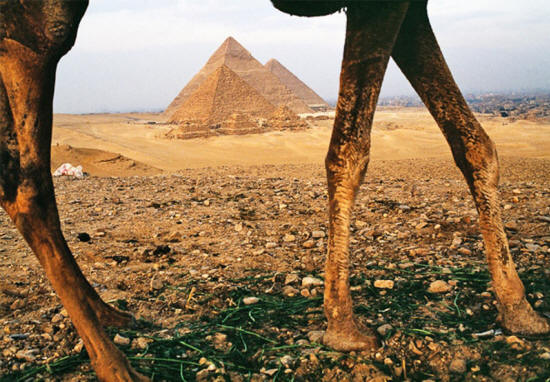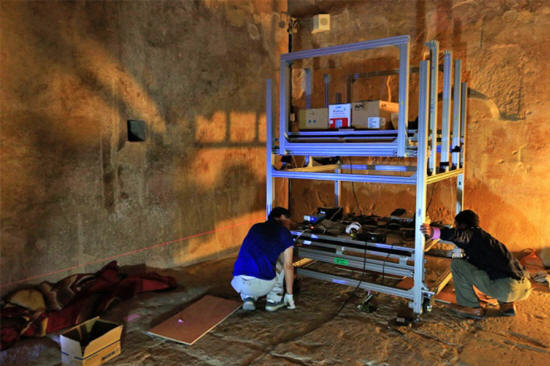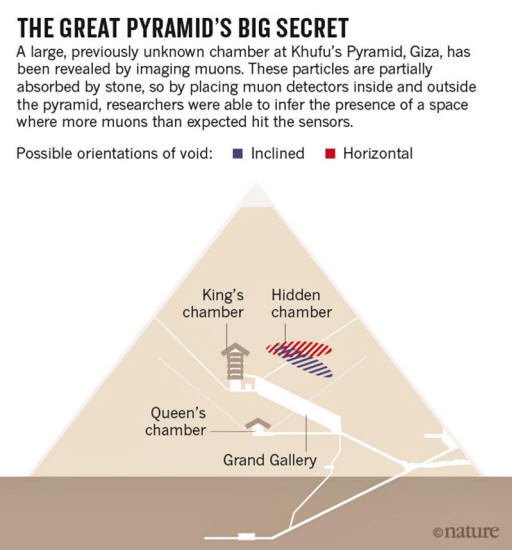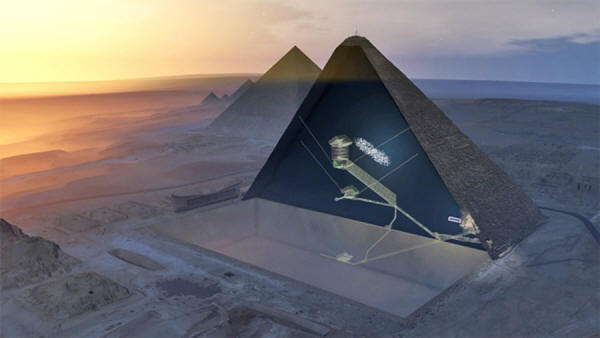|
has been found in the largest of the pyramids
in
Giza, Egypt. to discover a mysterious, 30-metre-long space, which could help to reveal how the 4,500-year-old monument was built.
The find is the first
discovery since the nineteenth century of a major new space inside
the pyramid.
But experts hope that the
finding will lead to significant insights into how this spectacular
pyramid was built.
Constructed from limestone and granite blocks, and rising to 139 meters, it is the oldest and largest of the Giza pyramids and one of the most impressive structures to survive from the ancient world.
These include the King's
chamber, which still holds a stone sarcophagus, the smaller
Queen's chamber and a sloping passageway known as the Grand Gallery.
But enthusiasts have wondered ever since whether there might be more hidden chambers inside the pyramid, or even whether the king's real 'burial chamber' is yet to be found.
So, he co-founded an international collaboration called Scan Pyramids to find out; the project was supervised by the Egyptian Ministry of Antiquities.
The group is "agnostic"
about particular theories, he says, but is using non-invasive
technologies to search for hidden chambers.
inside and outside the pyramid to find out whether theories of a hidden space
in the
Great Pyramid were true.
Around 10,000 muons rain down on each square meter of Earth's surface every minute.
Sensitive muon detectors have been developed for use in particle accelerators, but they have also been used in the past decade or so to determine the inner structures of volcanoes and to study the damaged nuclear reactor at Fukushima, Japan.
The particles are
partially absorbed by stone, so any large holes in the pyramid would
result in more muons than expected hitting the detectors.
To check the result, two other teams of physicists, from,
...then used different
types of muon detector placed in other locations both inside and
outside the pyramid.
The space is at least 30 meters long, with a similar cross section to the Grand Gallery.
The chamber could be either horizontal or inclined, the researchers say, and might be made up of two or more smaller spaces.
The purpose of the space is unknown, but Mehdi Tayoubi suggests that it could ,
With high, corbelled - or stepped - ceilings and mysterious stone benches, the Grand Gallery is,
Theories abound
Instead he speculates that the space might be a "relieving chamber", intended to reduce the weight of masonry pressing down on the Grand Gallery.
Similar relieving
chambers are seen above the King's chamber and in the pyramid of
Khufu's father, Sneferu,
at Meidum, another pyramid site in Egypt.
He wonders whether, just as the Grand Gallery leads to the King's chamber, the void might lead to another, higher chamber.
Bob Brier has a third theory.
In 2007, he and French architect Jean-Pierre Houdin suggested that the Grand Gallery formed part of a huge counterweight system. Weights sliding down the floor of the Grand Gallery could have raised the hefty, granite blocks that comprise the King's chamber, he says.
He speculates that the
new space could be part of a second counterweight system higher up.
and its
hidden chamber (white dots).
Tayoubi says that he next wants to scan Khafre's (also known as Chephren's) Pyramid, Egypt's second largest pyramid.
A team led by
Nobel-prizewinning physicist Luis Alvarez carried out muon
imaging in this pyramid in the late 1960s, using spark chambers as
detectors and recording the cosmic-ray data on magnetic tape.
But technology has improved dramatically since then, points out Tayoubi.
Video
|





